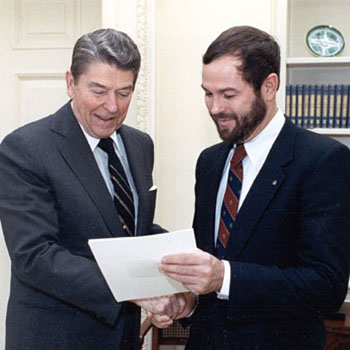Two great Americans
We need to take the next step. Our NEO search and tracking program continues to move forward, but nobody is taking responsibility for protection. I am more confident than ever in our ability to identify potential threats from asteroids and comets, but it is critical to the future of humanity that we develop the capabilities to protect ourselves from those threats
Representative Dana Rohrabacher, July 24, 2010, Space.com
| Congress Proposes Commission to Study Asteroid Impact Threat By Leonard David SPACE.com’s Space Insider Columnist posted: 19 July 2010 01:40 pm ET |
Lawmakers are paying new attention to how best to shield Earth from a bad day — getting whacked by an asteroid or comet that has our planet in its cross-hairs.
A new bill introduced to Congress proposes establishing a government-sponsored commission to study the threat of a major space rock collision with Earth and how prepared we are — as a country and a planet — to face such a danger.
There is a growing choir of concern regarding Near Earth Objects, or NEOs – spotting them and dealing with any Earth-threatening gatecrashers.
While the annual probability of the Earth being struck by a huge asteroid or comet is small, the consequences of such a collision are so calamitous that it is prudent to appraise the nature of the threat and prepare to deal with it, experts say. [Gallery: Holes in the Earth]
Last month, Representative Dana Rohrabacher (R – CA) introduced the new bill before Congress, H.R. 5587, titled: “To establish a United States Commission on Planetary Defense and for other purposes.”
The bill has been referred to the Committee on Science and Technology, on which Rohrabacher serves as a member. Both sides of the aisle are now looking at the commission idea.
Planetary readiness
“We need to take the next step,” Rohrabacher told SPACE.com. “Our NEO search and tracking program continues to move forward, but nobody is taking responsibility for protection. I am more confident than ever in our ability to identify potential threats from asteroids and comets, but it is critical to the future of humanity that we develop the capabilities to protect ourselves from those threats.”
Rohrabacher said that the Commission on Planetary Defense that he is proposing will review our planetary readiness for an impact event and make recommendations on how to develop an adequate response system to those threats.
As outlined in the bill, the purposes of the commission would be to:
- Determine capabilities of United States Government entities, nongovernment organizations, foreign governments and entities, and international bodies to detect, characterize, and neutralize potentially dangerous Near Earth Objects;
- Identify and evaluate roles and responsibilities of United States Government entities to detect, characterize, and neutralize potentially dangerous NEOs;
- Determine United States effectiveness in leading international efforts to detect, characterize, and neutralize potentially dangerous NEOs;
- Build upon United States Government and foreign analyses, studies, and assessments, without duplicating efforts, to determine current and required NEO characterization and mitigation capabilities;
- Identify and report on technology development required to provide effective planetary defense from dangerous NEOs; and
- Investigate and report to the President and Congress on its findings, conclusions, and recommendations for corrective measures that can be taken to provide planetary defense.
One function of the proposed seven-member commission is to assess the current ability of United States and foreign technology to defend our planet. Technologies that could aid the fight against a NEO threat include modeling and simulation capabilities, as well as nuclear devices, high order explosive systems, and laser systems.
The bill also requests a budget “not to exceed” $2 million for the commission.
Unexpected impact
Rohrabacher’s initiative joins a rising tide of interest in NEOs.
For example, earlier this year, the prestigious National Research Council issued a report on Defending Planet Earth: Near-Earth Object Surveys and Hazard Mitigation Strategies. This study was carried out at the joint request of NASA and the U.S. Congress.
The White House is engaged in identifying an agency to be responsible for NEO threat mitigation.
Similarly, the NASA Advisory Council Ad-Hoc Task Force on Planetary Defense is also deliberating on next steps.
Speaking at NASA’s Kennedy Space Center in Florida last April, President Barack Obama outlined plans for NASA that included sending an astronaut expedition to an asteroid by 2025. Such a trip could teach scientists a great deal about space rocks, including knowledge that might help prevent a calamitous collision with one.
Moreover, the Obama administration’s just-issued National Space Policy calls for pursuing capabilities, in cooperation with other departments, agencies, and commercial partners, “to detect, track, catalog, and characterize near-Earth objects to reduce the risk of harm to humans from an unexpected impact on our planet and to identify potentially resource-rich planetary objects.”
From his view, Rohrabacher concluded: “We know the threats are real. Earth has been hit many times with devastation ranging from local to regional, and even to planetary scales. It is just a matter of time until the threat appears again, and we must be ready.”


